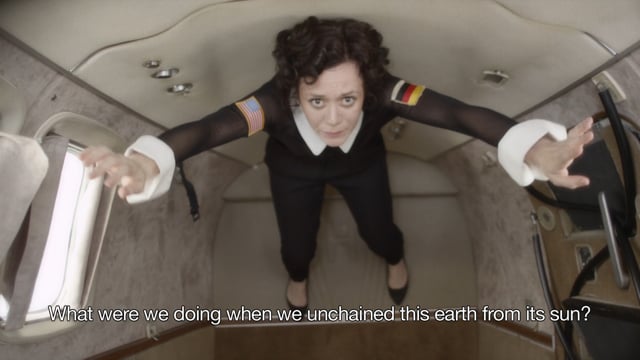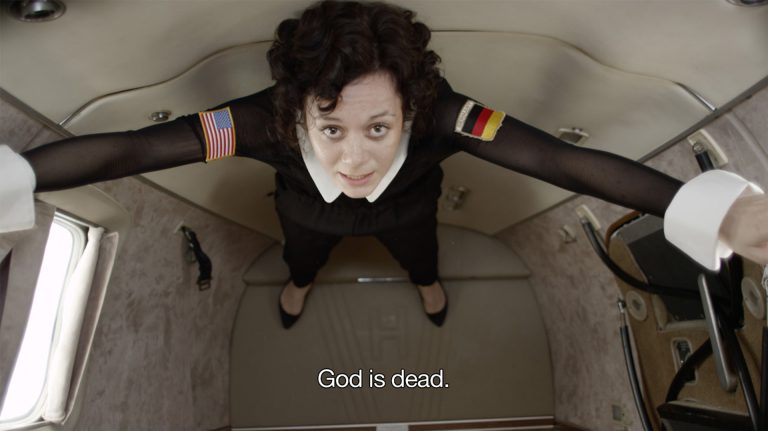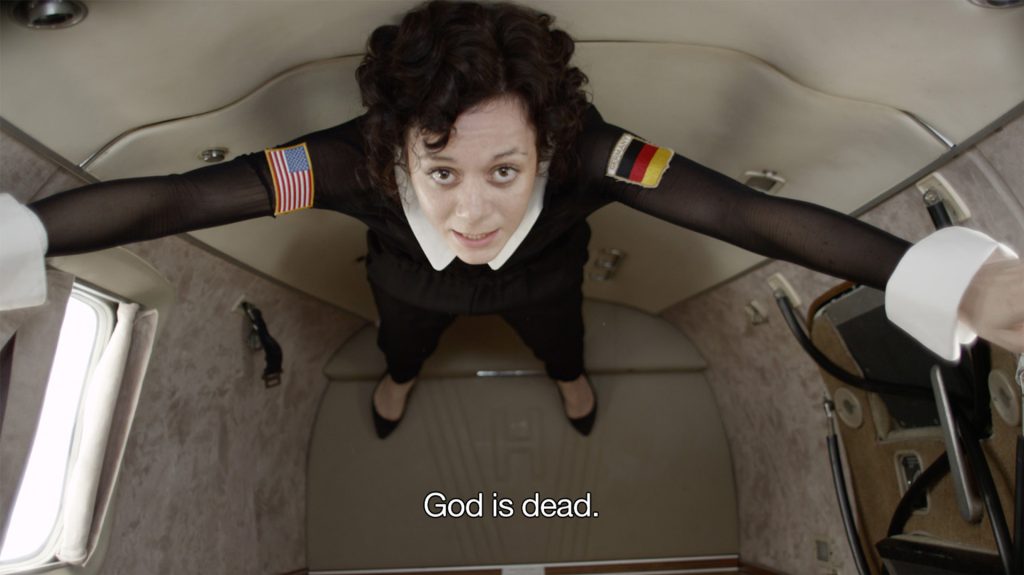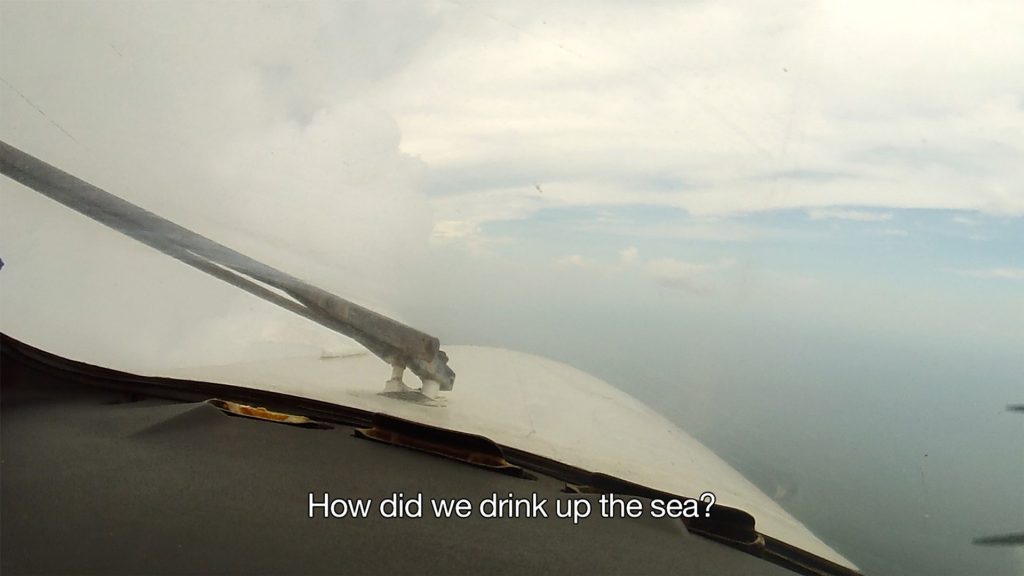
Zero Gravity
On 1 April 1966, a few decades after Friedrich Nietzsche, the question “Is God Dead?” was emblazoned on the cover of the US magazine Time, alarming about the growing atheism in America. Forty-seven years later, Nadja Verena Marcin set off into the weightlessness of a parabolic flight with the same question.
In "Zero Gravity", Marcin floats in the space of a jet over Tampa Bay in Florida. Wearing a black jumpsuit with a white collar, similar to an astronaut with American and German patches, she flies like a daredevil under the roof of the interior and quotes fragments from Nietzsche’s text “God is dead”.
The mad man of 1882 from The gay science remains a widely known atheist manifesto. Ironically, Marcin quotes the text in this day and age of lost religious faith. The weightiness and emotionality of the text meet a voice lit up by endorphins - as a physical reaction to flight.
With the work, the artist alludes to the lostness of humanity in a period of seemingly innumerable possibilities, where a brief feeling of happiness often replaces deeper contentment and long-term orientation is lacking. For Marcin, the heaviness of this text is at odds with weightlessness - as a human symptom.
Metaphorically and figuratively, Marcin becomes a crash test dummy in a celestial situation and tries to give impulses to rediscover our inner voice, deeper human needs and longings as well as a will and decision-making power.
The video was sponsored by WARP - Contemporary Arts Platform, Sint-Niklaas, and supported by Aurora Aerospace, Tampa. Zero Gravity
Zero Gravity
Video/Performance – 2013
HD Video, 2.33 min
In Zero Gravity (2013) Marcin floats in the space of a jet over Tampa Bay in Florida. In a black jumpsuit with a white collar, representing a space organization like an astronaut with patches of the American and German flags, she daringly flies under the roof of the interior, quoting fragments from Nietzsche’s text God is dead (1882).
The tale of The Mad Man (1882) remains a widely known atheism manifesto. Ironically, Marcin quotes the text in this moment where the consequences of lost religious belief have become apparent. The weightiness and emotionality of the text meet a voice enlightened by endorphins – as a physical reaction to the weightlessness in which she experiences an explosion of feelings of happiness.
The artist alludes to the forlornness of humanity in a period of innumerable possibilities of consumption, in which a short feeling of happiness often takes the place of deeper contentment, and a long-term orientation is lacking. For Marcin, the gravity of this text contradicts weightlessness – physical or menta – as a human symptomatology. Metaphorically and figuratively Marcin becomes a crash test dummy in a heavenly situation and tries to give impulses for the rediscovery of our inner voice, deeper human needs and desires.

Zero Gravity
On 1 April 1966, a few decades after Friedrich Nietzsche, the question “Is God Dead?” was emblazoned on the cover of the US magazine Time, alarming about the growing atheism in America. Forty-seven years later, Nadja Verena Marcin set off into the weightlessness of a parabolic flight with the same question.
In "Zero Gravity", Marcin floats in the space of a jet over Tampa Bay in Florida. Wearing a black jumpsuit with a white collar, similar to an astronaut with American and German patches, she flies like a daredevil under the roof of the interior and quotes fragments from Nietzsche’s text “God is dead”.
The mad man of 1882 from The gay science remains a widely known atheist manifesto. Ironically, Marcin quotes the text in this day and age of lost religious faith. The weightiness and emotionality of the text meet a voice lit up by endorphins - as a physical reaction to flight.
With the work, the artist alludes to the lostness of humanity in a period of seemingly innumerable possibilities, where a brief feeling of happiness often replaces deeper contentment and long-term orientation is lacking. For Marcin, the heaviness of this text is at odds with weightlessness - as a human symptom.
Metaphorically and figuratively, Marcin becomes a crash test dummy in a celestial situation and tries to give impulses to rediscover our inner voice, deeper human needs and longings as well as a will and decision-making power.
The video was sponsored by WARP - Contemporary Arts Platform, Sint-Niklaas, and supported by Aurora Aerospace, Tampa. Zero Gravity
EXHIBITIONS
S: Solo Exhibition | G: Group Exhibition | Sc: Screening
POST EDEN, Art Claims Impulse, Berlin, 2025 (G)
Glitch: Ontological Exhaustions & System Failures, Spazju Kreattiv, Malta, 2025 (G)
YES: Rachelle Beaudoin / Nadja Verena Marcin, Microscope Gallery, New York, 2017 (Sc)
01111010 (…), Esther Donatz as part of Kino der Kunst, Munich, 2015 (S)
Zero Gravity, Kunstverein Unna, Unna, 2014 (S)
Spring Show, 532 Thomas Jaeckel Gallery, New York, 2013 (S)
LECTURES
Masterclass – Nadja Verena Marcin, masterclass and Q&A, Festival Internacional Denis Stoklos de Solo Performance, Irati, 2022
Masterclass – Performance, fotografia e cinema: O processo criativo de Nadja Marcin, masterclass and Q&A, Cabíria Festival & Prêmio de Roteiro, Rio de Janeiro, 2020
PRESS
Verena Voigt: “Exhibition reflects on today’s technology-dependent society“, Times of Malta, 16 Mar 2025.
Sarah Corona, “L’arte senza Gravita”, Wallstreet International Magazine, New York, Dec 2013.
CATALOGS
Future Now – 100 Contemporary Artists From The Aesthetica Art Prize, York: Aesthetica Magazine Ltd, 2017. 180–181.
Verena Voigt, Spazju Kreattiv, Valletta Malta: GLITCH: ONTOLOGIGAL EXHAUSTIONS & SYSTEM FAILURES, Potsdam: Emblematic Pi*$©h, 2025.
CREDITS
Camera: Violetta D’Agata; Cut: Mike Lowther; Film Editor: Matz Müller; Concept, Art Director & Performance: Nadja Verena Marcin
SPONSORS
The project is made possible by WARP – Contemporary Arts Platform, Sint-Niklaas and Aurora Aerospace, Tampa.
PRIZE
Long listed for Aesthetica Art Prize, York, 2017


















